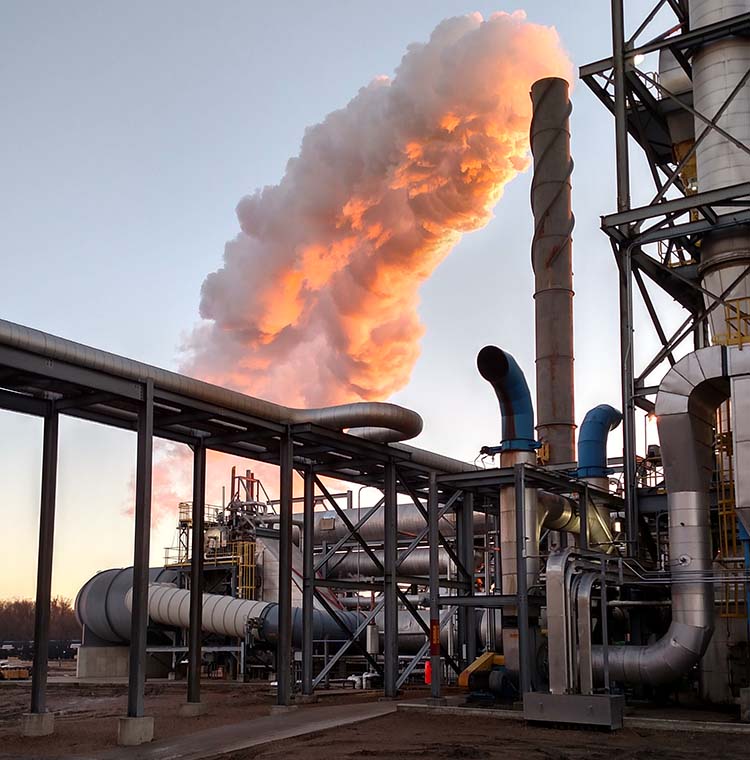AET staff work alongside innovative ethanol producers and regulators — providing compliance test data and working closely to meet the needs of all parties…
To address external market pressures, dry-mill ethanol plants have focused on producing a variety of co-products in addition to ethanol. The resulting emissions sources have led to innovations in emissions control.
Businesses worldwide are continually modifying products and services, looking for ways to serve new markets, and implementing new technology — all in response to a variety of factors. One of the best examples of adaptation in recent years can be found within the ethanol industry.
Ethanol producers solve a market challenge
Between 2011-2014, corn prices surged from $2-3 to $7-8 per bushel. Ethanol producers were unable to absorb or pass along this big increase in material costs to the customer.
The need for additional revenue streams convinced many producers to take a closer look at the various co-products of ethanol production, because one bushel of corn can produce much more than ethanol.
Only the starches of the corn are used in the ethanol fermentation process; the fats, oils, proteins, and other fibers are left behind. According to the Renewable Fuels Association, a single bushel of corn, on average, can produce 2.86 gallons of ethanol, 15.9 pounds of distiller’s grains, 0.75 pounds of corn oil, and 16.5 pounds of carbon dioxide.
These materials can be sold into local and international markets where they are used in several different industries. It wasn’t long before the ethanol industry began to realize the true value of its many co-products and took steps to adapt.
To mitigate external pressures, dry-mill ethanol plants had developed a strategy — develop, market, and sell these materials.
New technologies can lead to compliance issues
Since then, new technologies have emerged that increase efficiency and create additional co-products. One such technology focuses on further refinements to distiller’s grains. A recently developed process, known as Maximized Stillage Co-ProductsTM (MSC), concentrates distiller’s grains and delivers a high-protein product, which is sold into animal feed markets as a fortifier. Although implementing an MSC system requires a large capital investment of between $40-$50 million, several facilities have delved into this market due to the attractive prices that high-protein distiller’s grains fetch.
Installing an MSC system, however, will result in additional emissions sources at the facility.
As with any new emissions source, producers must develop and implement pollution-control plans, obtain air emissions permits, and establish testing regimes to mitigate any negative externalities. Qualifying and quantifying an emissions source for a new process can be tricky business. As we frequently see in the testing industry, theoretical values don’t always match actual test data when a new source comes on line. These unknowns can result in process disruption and other costly operational challenges.
In addition to innovations such as MSC systems, several engineering design firms in the Midwest have developed process add-ons for traditional ethanol production that reduce energy and water usage through reclamation. (Ethanol production, in general, is a water and energy-intensive process.) In addition to Heat Recovery/Steam Generators (HRSG), retrofitted energy recovery systems have made the ethanol production process more efficient and less resource-intensive, primarily by recycling hot, moist air (exhaust) that has already been thermally treated for pollution back into the process.
The benefits are two-fold: The energy within the exhaust is transferred out to pre-heat water entering the HRSG, and its condensation can now provide much-needed water for use in other areas of the plant, including pollution control via wet scrubbers and as a raw feedstock for fermentation.
Test data paves the way for new / emerging technologies
Because new technologies and retrofitted process add-ons aren’t typically part of the facility’s original design, they can have unknown effects on the ethanol production process. Collecting data on new and existing production systems can help producers better understand operations and allow them to achieve their desired efficiency and production rates.
The analysis of test data isn’t always straightforward and so we also aim to educate owners / operators and regulators on the testing process, so they have a better understanding of how our testing works, how results can be affected by operational or physical changes, and what the data means for them. We commonly provide the data that is used in setting permitted limits for a new source, so we work closely with regulators to make sure all parties needs are being met.
AET has been fortunate to work alongside innovative ethanol producers, both in providing compliance test data for owners and operators and working with design engineers to gather data to be used in future process development. Our role has given us valuable insight into the co-production process, and it is truly exciting to be a part of emerging technologies—both in ethanol production and emissions control.
James Dayton, who is based in our St Paul, Minnesota office, manages Air Permitting and Compliance, serving air quality clients across the Midwest. He can be reached at jdayton@teamAET.com.



